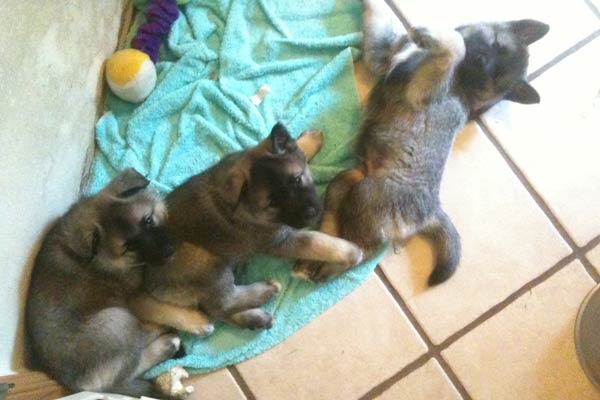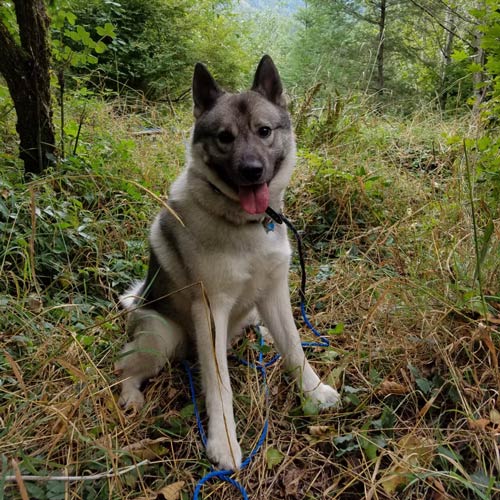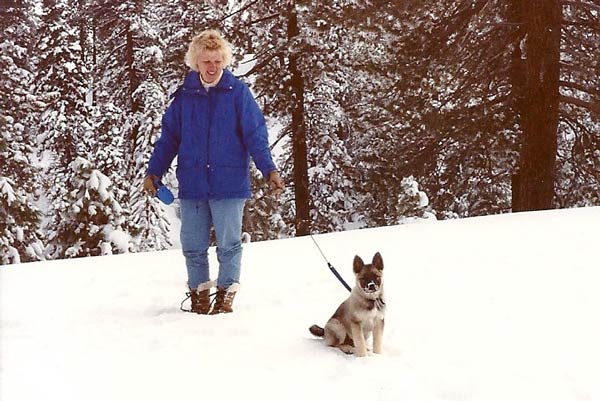
Bonnet started as Horton’s Novice A dog. The pair competed successfully all the way to a UDX title. The Norwegian Elkhound survived a stroke and was “truly a hero,” showing her owner “what was important in life that I did not already know” he says.
While he doesn’t have an iconic Superman “S” on his shirt, there were times in the past decade when it might have been appropriate. If Steve Horton is not up in the air shuttling passengers tens of thousands of miles nationwide, he’s on the ground taking dogs to training in every available spare moment.
The high-energy, 63-year-old, Seattle-based commercial airline pilot is also a Norwegian Elkhound owner-handler-breeder, along with his wife, Corinne Wanits. Horton has trained his Elkhounds with Kathy Lang at Family Dog Training Center in Kent, Washington since 1993.
He retired from the military in 1997, and went to work for a commercial airline. During those early years, he was low in seniority, and on “reserve,” meaning that for 15 hours a day, he was on a two-hour notice to report for flying duty. There were times Corinne had to help him manage the logistics of his personal and professional schedules so he could get to both dog classes and his job.

These puppies are older now, and training in Conformation, Obedience, and Agility at Family Dog Training Center in Kent, Washington.
“I wanted to attend training class at Family Dog, but in order to do that and still be able to respond to the callout, Corinne and I set up a procedure in which either the dogs would be left at the training facility for a really short callout, and Corinne would recover them there, or if time was a little less tight I could wait for her to arrive to do a face-to-face handoff of the dogs, while I changed into my uniform.
“This was complicated by the training facility’s distance from the house and the airport distance from both the house and the training facility, so time was tight.”
Packing up to attend training was complicated in those days, requiring a big checkoff list: the dogs, of course, training treats, training equipment and props, his uniform, flight bag with all flight manuals, and a suitcase with five days of clothing, since he had no idea how long he might be gone or where he might be going.
The reverse situation often happened, too. Upon returning from a flight, Horton would head straight to the training facility and change from his uniform into training clothes, while Corinne would deliver the eager dogs.

Tasha, 4½, and Horton work on increasing the distance between handler and dog in the early stages of agility training at Family Dog Training Center. Photo by Kathy Lang.
“It helps to have the best wife in the world who supports and shares this crazy dog passion,” he smiles. “She’s my soulmate and totally understands the dynamics of dog training and my schedule. She is a terrific trainer, too, but is sidelined a bit now with a back injury. But when I am gone, she, of course, handles all the dog duties at home with six Norwegian Elkhounds.”
Even now, with more seniority, Horton bids his monthly schedule evaluating what flight times will allow him to train his dogs twice weekly and fly his routes. In some cases, that again means arranging for his wife to either pick up or deliver the dogs to the training site.
Juggling work scheduling and high-priority dog events for Horton begins in September of each year when he plugs in his vacation days for the following calendar year. “You pretty much can’t have a summer vacation for dog shows until you have nearly 30 years with the company once you upgrade to captain. Each of my vacation blocks tends to be bid/placed upon the dog shows that we really want to attend,” he explains.

Titan pauses while on an outing with owner, Steve Horton, on his forested 75-acre Enumclaw, Washington, property. Horton plans to build a dog-training arena there in the near future.
Since Horton was upgraded to captain over 11 years ago, getting weekends off to attend dog shows has been an enormous challenge. “Only about two years ago could I start to get weekends off, but that came with a price – horrible flight schedules and destinations – for that month. This results in losing my scheduled training days in the middle of the week.”
Since the ‘90s, Horton has competed in Conformation, Obedience, Agility, and Rally. “My true enjoyment comes from Obedience,” he confesses. “Agility is fun. The dogs have fun. I have fun, but the challenge is not the same. Conformation is really nothing but a means to an end. Satisfaction is derived, but it’s not like I live for it. I consider Rally as a stepping stone to get ready for Obedience. Obviously, any time you can talk to the dogs they get a lot of feedback. Rally and Agility offer that. In Obedience, there is the need to have the dog work for delayed reinforcement.”
Together, he and Corinne have put 53 performance titles on their dogs.
So what kind of reactions do the dogs have when they see Horton put on his uniform and get ready to head out the door for his next flight?
“They vary,” he answers. “I have one who, the second he sees the white shirt with tie and shoulder epaulets, goes into the corner and sulks. Even when I try to get him to come out and say goodbye – yes, I say goodbye to each dog – he gives me this look that says you are leaving AGAIN! He has the pout down very well. The five others seem to want to get some time with me before I head out.

Titan relaxes after a fun training session. The 5-year-old dog is involved in Conformation and Obedience.
“The fun part is coming home. My wife claims the dogs know when I turn the corner to our road, a little over a mile away. One dog has to be the first to touch me, then she backs away to let others get to me, but she has to touch first. The male that sulks when I leave starts howling in joy and won’t stop for several minutes. If I don’t join in, he keeps restarting the howl until I participate with him. We howl together, and two or three others sometimes join in. It really is truly crazy for about five to 10 minutes. The longer I am away, the more intense the howlfest.”
The return home has another unique twist of goofy humor. The resourceful oldest female always goes through Horton’s flight kit, probing for treats. “She unzips each compartment with her lips and teeth, and gently removes whatever might be in the way like headsets, logbooks, etc., and does a complete search for leftover food that might be hidden someplace inside. She doesn’t put the items back inside, rather she places everything in a circle on the floor around the bag,” the engaging Horton laughs.
What is the appeal of the plucky Norwegian Elkhound, the 94th most popular AKC breed in the most recent 2016 standings, to the couple, both of whom had dogs while growing up?

Horton’s wife, Corinne, plays with puppy Shadow, the dog that initiated the couple into the AKC performance world.
The pair met and married while in the military, but that transitory lifestyle was not compatible with owning a dog. Finally, in the early 1990s, they were ready for a dog. They researched many breeds before settling on the Elkhound. “Our lifestyle and work still demanded any dog we had would have to be able to keep itself entertained and be self-sufficient and independent, as there would be times when we would be away for many hours.
“The Elkhound had been bred to act independently on its own, and to hunt moose, and only after it has done its job, to notify the hunter that he could show up and finish the job. That level of independence is often an issue, but that self-sufficiency and instinct are what helped draw us to the breed. The breed’s personality does present challenges at times, but I would not give it up for anything.”
Today they have six Elkhounds, ranging in age from 12 to 4½ years old, each of which has competed in one or more AKC sports.
In two years, Horton will reach the federally-mandated retirement age of 65 for commercial airline pilots. Then he expects to have considerably more time for dog sports. The couple will be moving to a 75-acre forested property in western Washington, which will have a training arena for Agility and Obedience, and plenty of space for long-line instruction.

Following an agility win, Shadow and Horton show off the ribbons. “Without Shadow, we would not have been in performance Elkhounds, and would not be involved in the training and competition that we are today,” notes Horton.
Asked if he has a bucket list of shows in which he hopes to enter upon retirement, Horton responds, “My wife would really like to show at Westminster. With the right dog, yes, but it is not real high on my list. I have this dream that we plan a trip in which we sightsee national parks throughout the country during the week, and on weekends we enter dog shows far and wide where no one knows who we are. Then we go in and score really well and disappear until the next weekend several states away, never to be seen by those people again. Just leave them wondering who we were and where we came from.”
You might call it the Horton mystique.

